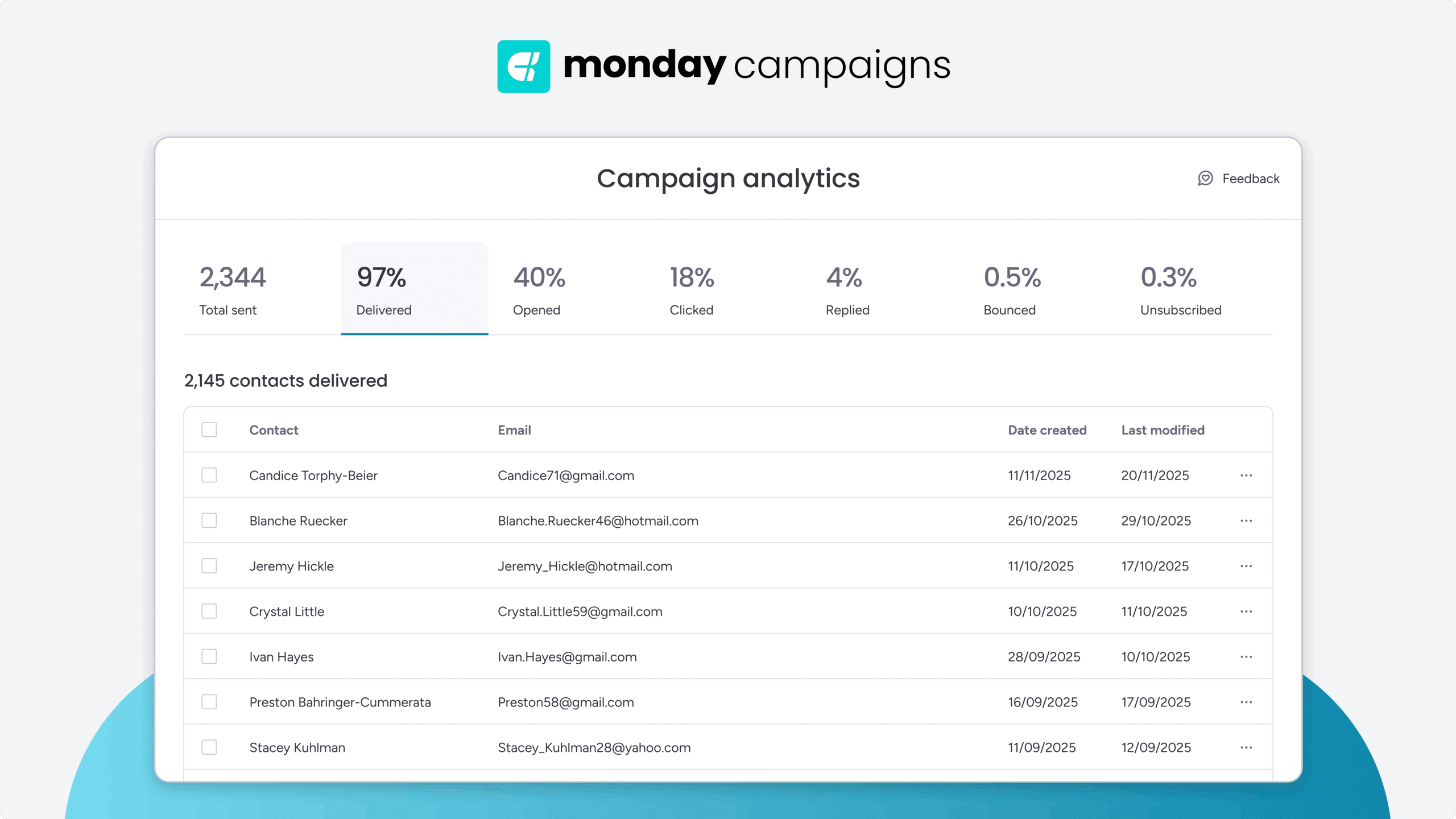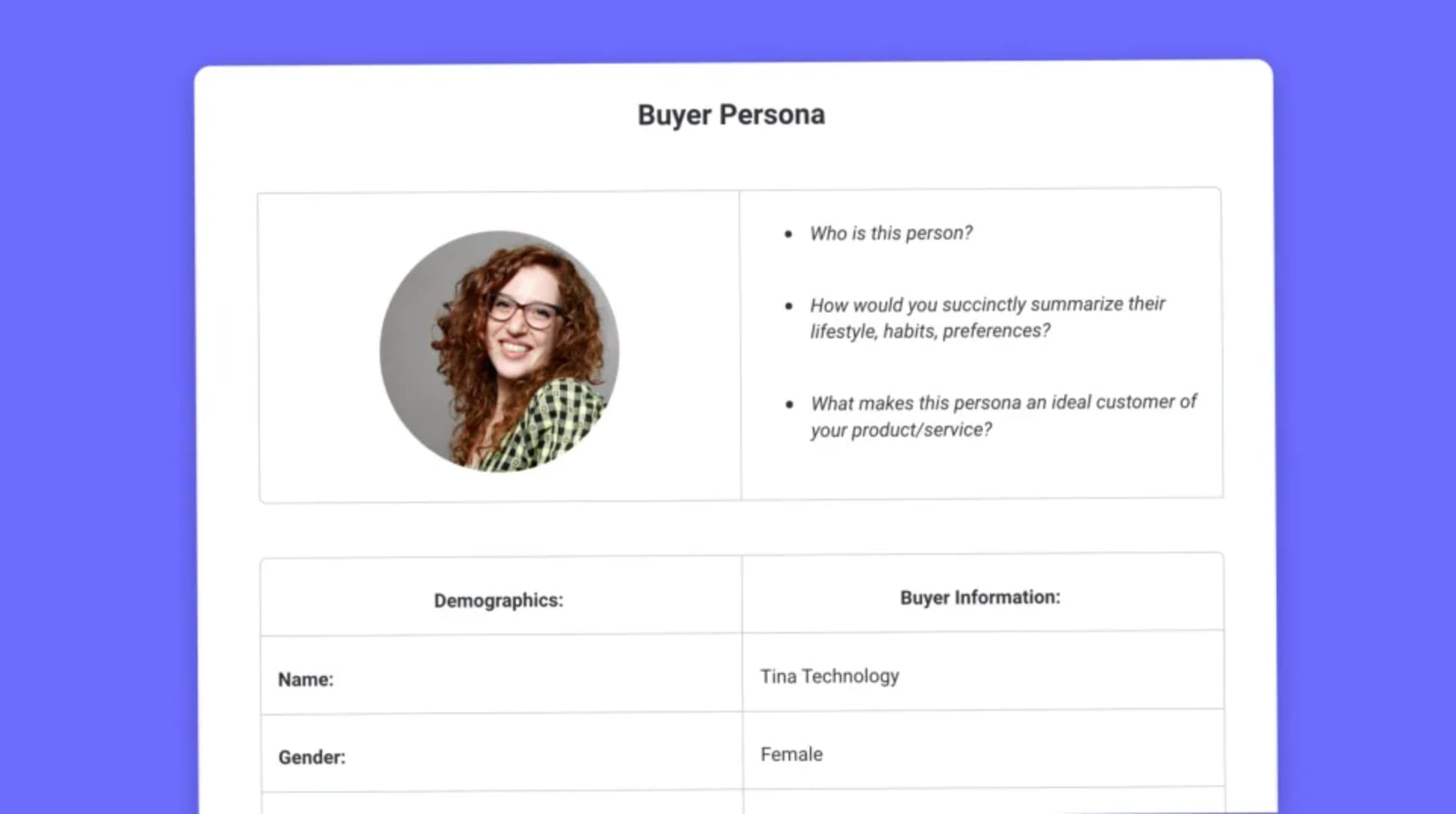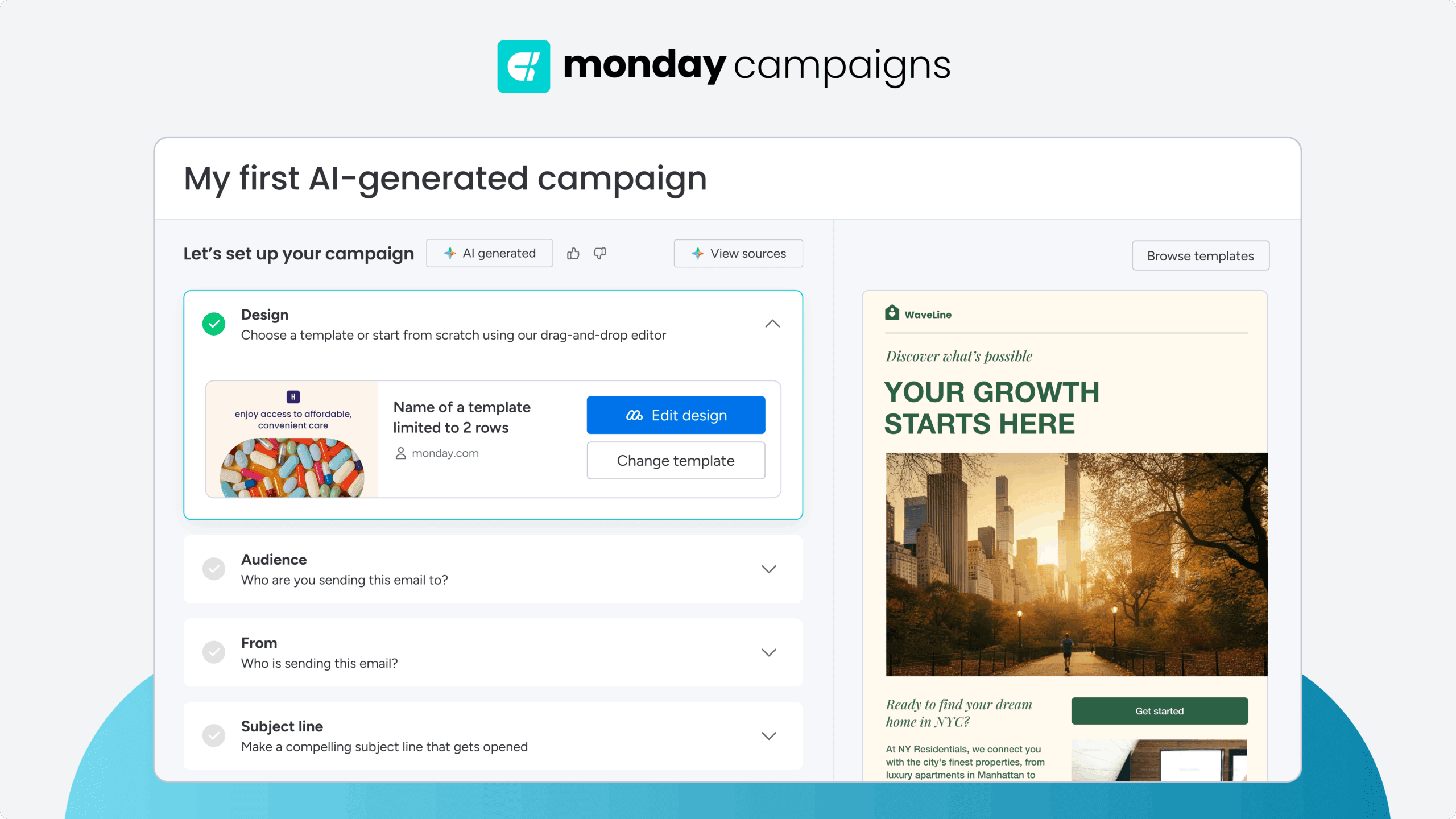Most marketing budgets are wasted. Not because the creative is bad or the channel is wrong, but because marketers send the message to everyone and therefore connect with no one. The single most effective way to boost marketing ROI is to stop marketing to everyone and focus intensely on your ideal target audience.
This guide shows you how to find your target audience and build actionable personas that reach the right people with the right message. You’ll also see how AI-powered platforms like monday campaigns turn audience data into campaigns that convert.
Try monday campaignsKey takeaways
- Target audiences are specific groups most likely to buy from you, so focus marketing to people who share key characteristics like demographics, interests, and buying behaviors.
- Understanding your target audience dramatically improves marketing ROI by reducing wasted spend and increasing conversion rates through messages that actually resonate.
- Use a systematic 6-step process to find your audience: analyze customer data, research your market, study competitors, use analytics, listen on social media, and test different segments.
- Create detailed buyer personas that include demographics, pain points, goals, and customer journey maps to guide every marketing decision from content creation to channel selection.
- AI-powered platforms like monday campaigns automatically segment audiences and create personalized campaigns based on real customer intelligence, connecting insights directly to execution.
What is a target audience?
A target audience is a specific group of people most likely to buy your product or service. This means they share characteristics that make them ideal customers — things like age, interests, location, or buying habits.
Think of it like this: if you’re selling running shoes, your target audience isn’t everyone who walks. It’s people who run regularly, care about performance, and have the budget for quality footwear.
Target audience vs. target market
Your target market is everyone who could potentially buy from you. Your target audience is the specific group you’re actively trying to reach right now. For example, a coffee shop’s target market might be all coffee drinkers in their city. But their target audience for a new loyalty program might be daily customers who spend over $5 per visit.
This distinction matters because it keeps your marketing focused while maintaining strategic flexibility, something a positioning statement template can clarify. Your market stays broad, but your campaigns stay targeted.
How the right target audiences drive marketing success
Without a defined target audience, you’re essentially shouting into the void. You create generic messages that speak to everyone but connect with no one.
When you know exactly who you’re targeting, every marketing decision becomes simpler and more effective, including how you structure your marketing funnel. Your messages resonate because they address specific needs. Your budget works harder because you’re not wasting money on people who’ll never buy, which is also vital when shaping your go to market strategy.
Here are some key benefits to having refined target audiences built into your marketing strategy:
Boost your marketing ROI
Targeted marketing delivers measurably higher returns because your budget reaches the right people. Instead of spreading resources thin across everyone, you focus on high-potential segments.
- Higher conversion rates: Your messages speak directly to audience needs
- Lower acquisition costs: You’re not paying to reach uninterested people
- Faster results: Relevant messaging drives quicker decisions
Create more meaningful customer connections
Understanding your target audience enables personalized communication that builds trust. When customers feel understood, they engage more and stay longer, which is a core principle of relationship marketing. Research shows that 71% of consumers expect companies to deliver personalized interactions, and 76% get frustrated when this doesn’t happen.
This goes beyond using someone’s name in an email. It means knowing their challenges, speaking their language, and offering solutions that actually fit their situation, which is the heart of a strong creative strategy.
Differentiate from competitors
Deep audience insights reveal opportunities your competitors miss. Maybe they’re ignoring a specific pain point or using language that doesn’t resonate.
When you truly understand your audience, you can serve them in ways others can’t. This creates a competitive advantage that’s hard to copy.
Try monday campaigns3 types of target audience data
Not all audience data is created equal. To truly understand who you’re marketing to, you need to look at 3 distinct layers of information. Each reveals different insights about your audience — and together, they create a complete picture of the people most likely to buy from you.
1. Demographics
Demographics are the basic facts about your target audience — the measurable characteristics that help you identify who they are. These include age, income, gender, location, education, and occupation.
Why do demographics matter? Because a 25-year-old college student shops differently than a 65-year-old retired executive. They use different platforms, respond to different messages, and have different budgets.
2. Psychographics
Psychographics dig deeper into why people buy. This includes values, lifestyle choices, personality traits, and attitudes that drive purchasing decisions.
Two people might have identical demographics but completely different psychographics. For example, one values sustainability and ethical brands while the other prioritizes convenience and luxury. Same age, same income — totally different marketing approach needed.
3. Behavioral patterns
Behavioral patterns show how your audience actually interacts with brands. This covers buying frequency, brand loyalty, product usage, and decision-making processes.
Some customers research for weeks before buying. Others make impulse purchases. Some prefer email communication, while others only engage on social media. Understanding these patterns helps you reach people when and where they’re most receptive.
What about firmographics?
Firmographics apply the same idea as demographics — but for organizations instead of individuals. They describe a company’s size, industry, revenue, location, and structure. If you sell B2B products or services, firmographics help you pinpoint the right kind of business to target.
For example, a marketing automation platform might focus on SaaS companies with 50–200 employees and high growth potential, while a consulting firm could target enterprises in regulated industries.
4 main types of target audiences
Understanding different audience types helps you create more sophisticated targeting strategies. Most successful campaigns combine multiple types for maximum impact.
1. Purchase intent audiences
Purchase intent audiences are actively shopping for what you sell. They’re searching for solutions, comparing options, and ready to buy soon.
- Search behavior: Looking for specific products or solutions
- Website actions: Adding items to cart or requesting demos
- Content engagement: Reading buying guides or comparison articles
2. Interest-based audiences
Interest-based audiences share hobbies or preferences related to your product. They might not be shopping yet, but their interests suggest future potential.
A camping gear company might target outdoor enthusiasts, hikers, and nature photographers. These people aren’t always buying tents, but when they need one, you want to be top of mind.
3. Subculture audiences
Subculture audiences unite around shared values, lifestyles, or identities. They often show fierce brand loyalty when you earn their trust, and working with influencers who share these values can amplify your reach.
Examples include gaming communities, fitness enthusiasts, or environmental advocates. Marketing to subcultures requires authenticity — they can spot fake engagement immediately.
4. B2B and B2C audiences
B2B audiences focus on business outcomes, ROI, and solving organizational challenges, which is why B2B marketing strategies use more data-driven approaches. B2C audiences make more emotional, personal decisions.
B2B typically involves:
- Multiple decision-makers: Various stakeholders must approve
- Longer sales cycles: Weeks or months of evaluation
- Rational criteria: Focus on efficiency and measurable results
B2C usually features:
- Individual decisions: One person chooses
- Shorter cycles: Minutes to days
- Emotional drivers: Personal benefits and experiences
6 steps to find your target audience
Finding your target audience requires systematic research, not guesswork, which is why a market segment template can help classify relevant traits more effectively. These steps build a complete picture of who to target and how to reach them.
Step 1: Analyze your customer data
Start with what you already know. Your existing customers hold valuable clues about who else might buy from you.
Look for patterns in your CRM data, purchase history, and customer service interactions by using a customer segment template. Which customers spend the most? Stay the longest? Refer others? These patterns reveal your most valuable segments and make customer segmentation more effective for identifying key behaviors.
Step 2: Research your market
Expand beyond current customers to understand the full market opportunity. Industry reports and market research reveal trends and untapped segments, a key foundation for data-driven marketing.
Conduct surveys and interviews to gather direct feedback. Ask about challenges, preferences, and what influences buying decisions. This qualitative data adds context to your numbers.
Step 3: Study competitor audiences
Analyze who competitors target through their social media, advertising, and content with a dedicated competitive analysis to pinpoint gaps. Look for gaps — underserved segments or unaddressed needs.
Don’t copy competitors directly. Instead, find unique angles to serve similar audiences more effectively.
Step 4: Use digital analytics
Website analytics and social media insights reveal detailed audience behavior. Google Analytics shows visitor demographics, interests, and on-site actions.
With monday campaigns, these data sources are integrated to create unified audience profiles. This comprehensive view enables more precise targeting across all channels, which is crucial for effective marketing management.

Step 5: Listen on social media
Social listening reveals unfiltered audience conversations. Monitor what people say about your industry, competitors, and the problems they face.
- Language used: How they describe challenges
- Questions asked: What information they need
- Communities joined: Where they gather online
Step 6: Test and optimize
Validate your assumptions through small-scale campaigns. See which segments convert best, then refine based on performance data.
Finally, turn those insights into clear buyer personas — profiles that capture real customer goals and pain points. With monday campaigns, you can instantly apply these learnings to live campaigns, connecting audience intelligence directly to action.

How to reach your target audience
Knowing your audience means nothing if you can’t reach them effectively. Success requires matching insights with the right channels and messages.
Lean on email marketing
Email remains highly effective when powered by smart segmentation. Your audience research directly improves email performance through relevant content and timing.
- Behavioral segmentation: Group by actions, not just demographics.
- Journey-based content: Match messages to customer stage.
- Dynamic personalization: Adapt content based on engagement.
With smart software like monday campaigns, you can automate the complexity of email marketing through AI-powered segmentation that updates in real-time.

Build an intentional social media strategy
Different audiences prefer different platforms: LinkedIn for B2B professionals, Instagram for visual lifestyle brands, and TikTok for younger consumers. What works on LinkedIn could feel stiff on Instagram, so match your content style to each platform while maintaining consistent brand messaging.
Craft content that resonates
Create content addressing your audience’s specific challenges and interests. Generally speaking, generic industry content gets ignored while targeted content gets shared.
Use your audience’s language. If your buyers are using language like “I really struggle with team communication,” don’t use language like “How to optimize collaborative workflows.”
Launch strategic paid campaigns
Paid advertising platforms offer precise targeting that matches your research, so working like a digital marketing agency can help you harness multiple ad channels effectively.
Create different ad versions for different segments. Demographics, interests, and behaviors can help you build laser-focused, highly segmented campaigns. Remember: A startup founder needs different messaging than an enterprise executive, even if they’re buying the same product.
Try monday campaignsTarget audience examples by industry
Target audiences look different across industries, but the principle stays the same: specificity wins. Here are a few real-world examples showing how businesses define and reach their ideal customers:
| Example | Target audience description |
|---|---|
| Marketing automation platform (B2B) | • Marketing managers at B2B SaaS companies with 50–200 employees • Struggle with lead nurturing and proving marketing ROI • Value easy implementation and alignment with sales teams |
| Cybersecurity consulting (B2B) | • IT directors at financial services firms • Concerned about compliance and data protection • Seek proven expertise, clear methodologies, and minimal disruption |
| Organic meal kit delivery (B2C) | • Health-conscious parents aged 30–45 in suburban areas • Want convenient, healthy meals but lack time to plan • Respond to family-focused messaging and nutritional transparency |
| Online fitness platform (B2C) | • Remote workers aged 25–40 • Prefer flexible, at-home workout options • Value variety, progress tracking, and community support |
How monday campaigns uses AI to transform target audience marketing
AI intelligence powers every stage of audience targeting within monday campaigns — from data collection to personalized campaign execution. Continuously learning from CRM data, monday campaigns refines who you target, how you message them, and when you engage.
Dynamic segmentation automatically groups contacts based on real behavior patterns, while predictive analytics surface the prospects most likely to convert. AI-generated content suggestions adapt messaging for each segment, ensuring every interaction feels personal rather than generic.
Some key features of monday campaigns include:
- Intelligent automation: Launch campaigns instantly when CRM data changes, such as when a deal moves stages or a customer takes action.
- Optimal timing: Use AI-driven send-time recommendations to reach audiences when they’re most engaged.
- Performance analytics: Measure engagement and conversion across the entire customer journey to continuously improve results.
Because monday campaigns is fully integrated with monday CRM, audience insights connect directly to campaign execution. Data doesn’t sit in silos — it fuels action. Marketing and sales teams can collaborate in real time, launch campaigns from live CRM data, and track results within a single shared workspace.

Launch smarter, more connected campaigns
Understanding your target audience is only the first step. Turning those insights into meaningful engagement is where results happen. With audience data, content creation, and campaign automation all connected in one place, monday campaigns makes it simple to move from insight to impact.
Within a single shared workspace, marketing and sales teams can collaborate on campaign strategy and execution in real time, build and automate personalized workflows based on live CRM data, and monitor performance and optimize messaging using AI-driven insights.
Unite your audience intelligence with day-to-day execution, so every campaign is more targeted, every message more relevant, and every action measurable
Try monday campaignsFAQs
What is an example of a target audience?
Your target audience example depends on your business type. For a project management platform, it might be operations managers at growing companies who struggle with team coordination. For a fitness app, it could be busy professionals aged 25-40 who prefer home workouts over gym memberships. Each audience shares defining traits — goals, pain points, and behaviors — that help shape messaging and campaign strategy.
What are the 4 types of target audiences?
The 4 types of target audiences are purchase intent (actively shopping), interest-based (share relevant hobbies), subculture (united by values or lifestyle), and B2B versus B2C (business buyers versus individual consumers). Most businesses target multiple types simultaneously.
How do you identify your target audience in marketing?
You identify your target audience in marketing by analyzing existing customer data, researching your broader market, studying competitor audiences, using digital analytics, listening on social media, and testing different segments. This systematic approach reveals who’s most likely to buy from you.
What is the difference between target market and target audience?
Target market is the broad group of all potential customers who could buy your product. Target audience is the specific subset you’re actively trying to reach with current marketing efforts. Your market might be all coffee drinkers, but your audience is urban professionals who buy premium coffee.
How often should you update target audience research?
Target audience research should be updated every 6-12 months or whenever significant market changes occur. Regular updates ensure your marketing stays relevant as customer preferences and competitive landscapes evolve.
Can a small business have multiple target audiences?
Yes, small businesses can have multiple target audiences. A local bakery might target both wedding planners for custom cakes and neighborhood families for daily bread. The key is creating distinct marketing approaches for each audience while maintaining consistent quality and brand values.
 Get started
Get started 

